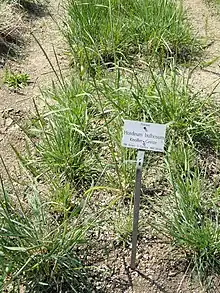Hordeum bulbosum
Hordeum bulbosum, bulbous barley, is a species of barley native to southern Europe, northern Africa, the Middle East and as far east as Afghanistan, with a few naturalized populations in North America, South America and Australia. Since 1970 it has been used in the Hordeum bulbosum Method (or Technique) to produce doubled haploid (DH) wheat and barley plants by crossing it with T. aestivum or H. vulgare, followed by the elimination of the H. bulbosum chromosomes from the offspring.[2] These DH plants are important in breeding new varieties of wheat and barley, and in scientific studies. H. bulbosum is also being looked at as a source of genes for disease resistance and other traits for barley crop improvement.[3]
| Hordeum bulbosum | |
|---|---|
 | |
| Hordeum bulbosum at the Botanical Garden Munich-Nymphenburg | |
| Scientific classification | |
| Kingdom: | Plantae |
| Clade: | Tracheophytes |
| Clade: | Angiosperms |
| Clade: | Monocots |
| Clade: | Commelinids |
| Order: | Poales |
| Family: | Poaceae |
| Subfamily: | Pooideae |
| Genus: | Hordeum |
| Species: | H. bulbosum |
| Binomial name | |
| Hordeum bulbosum | |
| Synonyms | |
References
- Cent. pl. II:8. 1756 (Amoen. acad. 4:304. 1759)
- Devaux, P. (2003). "The Hordeum bulbosum (L.) method". Doubled Haploid Production in Crop Plants. pp. 15–19. doi:10.1007/978-94-017-1293-4_3. ISBN 978-90-481-6393-9.
- Ullrich, Steven E. (2011-01-25). Barley: Production, Improvement, and Uses. ISBN 9780813801230.
This article is issued from Wikipedia. The text is licensed under Creative Commons - Attribution - Sharealike. Additional terms may apply for the media files.